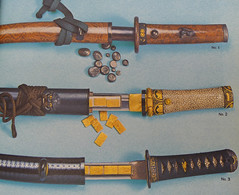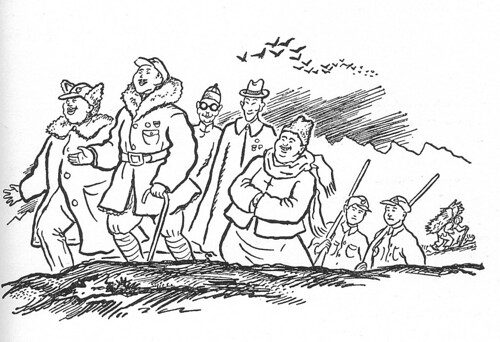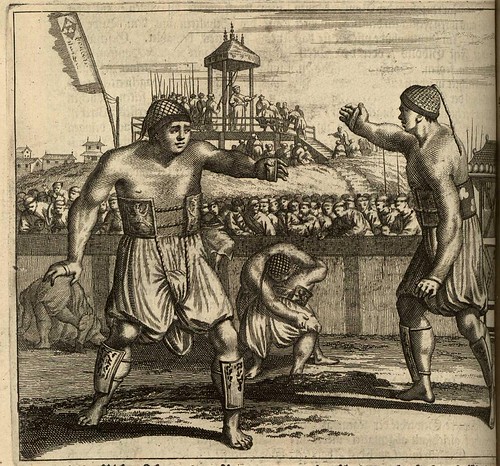Two Western Zhou bronze inscriptions, both dating from around 850 B.C. and describing the war against the Xianyun1
It was the ninth month, first auspiciousness, wushen-day (no. 45), Boshi said:
“Buqi, the Border Protector! The Xianyun broadly attacked Xiyu, and the king commanded us to pursue to the west. I came back to send in the captives. I commanded you to defend and to pursue at Luo, and you used our chariots sweepingly attacking the Xianyun at Gaoyin; you cut off many heads and took
many prisoners. The Rong greatly gathered and followed chasing you, and you and the Rong greatly slaughtered and fought. You have done well, and have not let our chariots get trapped in difficulty. You captured many, cutting off heads and taking prisoners.”Boshi said: “Buqi, you young man! You are nimble in warfare; [I] award you one bow, a bunch of arrows, five households of servants, ten fields of land, with which [you are] to take up your affairs.” Buqi bowed with [his] head touching the ground, [and extols the] the beneficence. [Buqi] herewith makes for my august grandfather Gongbo and Mengji [this] sacrificial gui-vessel, with which to entreat much good fortune, longevity without limits, and eternal pureness without end. May [my] sons’ sons and grandsons’ grandsons eternally treasure and use [it] in offerings.
__________
It was in the tenth month, because the Xianyun greatly arose and broadly attacked Jingshi, [it] was reported to the king. The king commanded Duke Wu: “Dispatch your most capable men and pursue at Jingshi!” Duke Wu commanded Duoyou: “Lead the ducal chariots and pursue at Jingshi!”
On the guiwei (no. 20) day, the Rong attacked Xun and took captives. Duoyou pursued to the west. In the morning of the jiashen (no. 21) day, [he] struck [them] at Qi. Duoyou had cut off heads and captured prisoners to be interrogated: in all, using the ducal chariots to cut off 2 [X] 5 heads, to capture 23 prisoners, and to take 117 Rong chariots; [Duoyou] liberated the Xun people captured [by the Xianyun].
Furthermore, [Duoyou] struck at Gong; [he] cut off 36 heads and captured 2 prisoners and took 10 chariots. Following [the Xianyun], [Duoyou] pursued and struck at Shi; Duoyou again had cut off heads and taken prisoners. Thereafter, [Duoyou] rapidly pursued [them] and arrived at Yangzhong; the ducal chariotry cut off 115 heads and captured 3 prisoners. It was that [they] could not capture the [Rong] chariots; they burnt [them]. And it was their (the Xianyun’s) horses that they wounded gravely. [Duoyou] recaptured the Jingshi captives.Duoyou contributed the captured, the heads, and the prisoners to the duke, and Duke Wu then contributed [them] to the king. [The king] therefore addressed Duke Wu and said: “You have pacified Jingshi; [I] enrich you and award you lands.” On the dingyou (no. 34) day. Duke Wu was in the Xian-hall [He] commanded Xiangfu to summon Duoyou, and [Duoyou] entered the Xian-hall. The duke personally addressed Duoyou and said: “I initially assigned [you the task], and you have done well! [you] did not disobey, but have accomplished [the deed and] taken many captives. You have pacified Jingshi. [I] award you one jade tablet, one set of bells made in finest bronzes and one hundred jun of the jiaoyou copper.” Duoyou dares to respond to the duke’s beneficence, and herewith makes [this] sacrificial ding-vessel, with which to entertain friends; may my sons’ sons and grandsons’ grandsons eternally treasure and use it!2
This semester I am only teaching three classes, one section of East Asia History, one of Early China, and an Honors College class the first part of which is about ancient Chinese bronzes. So I have been going over some of the same things at three different speeds with three (mostly) different groups of students. This would seem to be a situation that is ripe for all sorts of profound insights. Sadly, I do not have too many.3 Teaching Early China has changed a lot since I was a kid, in part because of all the archeological work that has been done since 1976. Pre-Han stuff used to centered on the philosophers and their (fairly disembodied) debates, in large part because philosophical texts were about all we had. When Fairbank and Twitchett first started the Cambridge History of China project (back in the 1960’s) they deliberately left out the Pre-Qin period on the grounds that “It may well be another decade before it will prove practical to undertake a synthesis of all these new discoveries that will have lasting value. ”4 The Cambridge History of Ancient China, which came out in 1999 was intended to remedy this problem. In the last 30-odd years not only have we made a lot of progress in understanding classical texts but there has been a huge amount of progress in understanding the social and political systems of the Shang and Zhou in large part becuse of archeological evidence like the above. It used to be pretty much impossible to discuss the actual workings of Zhou feudalism with students, or to have a meaningful debate on the validity of “feudalism” as a concept in China, or to do lots of other stuff. Textbooks have not really caught up with this, but it is getting easier and easier for even non-specialists to teach Early China.
from Li Feng Landscape and Power in Early China ↩
Zhou bronze inscriptions sound a lot like blog posts ↩
One is that if you are teaching similar courses in the same semester you should try to at least get them scheduled for different rooms, which might reduce the number of times you end up asking the students if you have gone over this point with them before. ↩
General Editor’s Preface ↩






